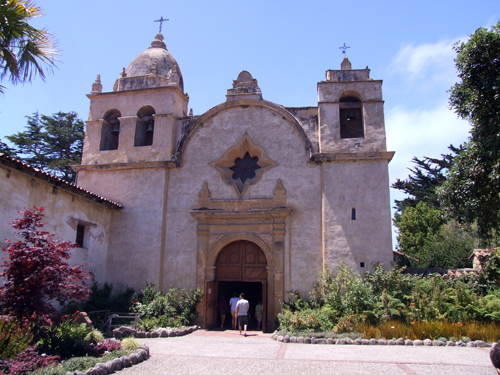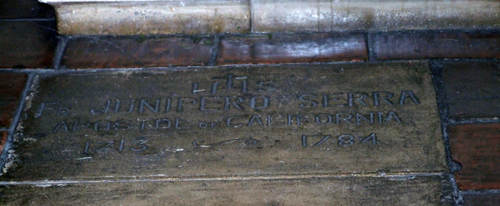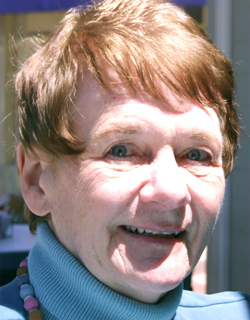
By Donald H. Harrison
CARMEL, California – In some parts of the world, particularly Europe, the saint for whom Mission San Carlos Borromeo del Rio Carmelo is named is better known than the man nominated for sainthood whose body is buried under the floor next to the altar.
But here in California, the reverse is true. Father Junipero Serra, founder of the California mission system, is by far the better known—and more controversial of the two. Since 1988 when Serra was beatified by Pope John Paul II, objections have been raised by Native American groups against his potential canonization. According to their objections, California missions were cruel to the Indians who were recruited to Christianity, and beatings were common.

Carlos Borromeo, who as a cardinal served as the archbishop of Milan and was also an important figure in shaping the Catholic church’s 16th century response to the Protestant reformation, lies in mummified condition in a crystal coffin which may be viewed by visitors to the Milan Cathedral. He is revered because when plague ravaged Europe, he went out among the people to minister to them, rather than remaining safe in his quarters.
Serra’s resting place, though exalted, is far more humble than that. The body of the 18th century Franciscan padre lies in privacy under the sanctuary floor. It is between the bodies of his assistant, Father Juan Crespi, and his successor as president of the missions, Father Fermin Lasuen. All three men were major figures in California history during its Spanish colonial period.
The town of Carmel was named after the area near Haifa, Israel, where, according to the Bible, the Prophet Elijah demonstrated in a contest that the prophets of Baal were serving a false god. Among the duties of Cardinal Carlos Borromeo (“Carlo” in Italian) was the administration of various monastic orders, including the Carmelites.

Maureen Bianchini, a docent, refrains from discussing the doctrines of Catholicism with visitors to the mission, saying that is the job of the priests and other religious personnel. History, on the other hand, is her forté and the subject of Father Serra and his Native American wards is a matter of great interest to her. Bianchini, married to a man of Italian descent, is herself descended both from Irish immigrants and Sac Fox Indians, a tribe that is found mainly in the Midwestern states of Oklahoma, Missouri and Iowa.
Bianchini said the idea that Serra was cruel to the Indians was promulgated by Americans who wanted to shift the onus for mistreating Indians from their fellow Americans to the Spaniards. “I am part Indian and I know what they (Americans) did to the Indians back east,” she said, adding that it is victors who get to write histories – and that’s what Americans did when they told about the Spanish and Mexican cultures that they had supplanted.
Those who spread atrocity stories about Serra “were very anti-Catholic, anti-Spanish, anti-Mexican – anti-anyone- with-darker- skin,” Bianchini asserted. “In fact, under the Spanish and Mexican governments, the land was supposed to go back to the natives — like it did in Mexico . There were no Indian reservations in Mexico. When they (indigenous peoples) were converted or made into good little Europeans, the land would go back to them.”
In California, after the secularization of the missions, Mexican rulers divided the lands into large ranchos for themselves, and “weren’t going to give it back to the Indians, but then the Americans came along and they took it away from everybody,” she said. “The Mexicans, Spanish, Indians were all considered the same…”
While Bianchini’s account may sound novel, she says it is slowly gaining acceptance among other Native Americans. “A lot of Native Americans — and there are several in the parish– know that intellectually, “ she said. However, the “myth” of Serra mistreating Indians has been repeated for so many years, it is a difficult concept for many to give up, she added.
Mission San Carlos Borromeo del Rio Carmelo – better known as the Carmel Mission –in 1770 became the second in the California mission chain to be founded. The first, in 1769, was the mission in San Diego. Like that in San Diego, the Carmel mission was moved from its original location and for similar reasons. Initially San Diego’s mission was located at the Presidio in San Diego, and Mission San Carlos Borromeo was located at the Presidio in Monterey – both garrisoned with Spanish soldiers who protected the ports near where the missions were situated.
Living without women, the Spanish soldiers cast covetous eyes on the Native American women and both missions were moved away from the Presidio to discourage soldiers from thoughts of rape, Bianchini said. Both missions were moved to locations that were close to sources of fresh water and which had villages of Native American people situated close by. These villages remained home to the Native Americans throughout the Mission period; very few lived on the grounds of either mission, Bianchini reported.
Serra decided to make Carmel his headquarters, where his life followed a monastic routine. One can see a re-creation of the room, or cell, in which he slept – similar to the one which may be viewed at the San Diego Mission. Here there is also a salon similar to one in which he met with visitors and officials during the conduct of mission business. Much of his time between 1770, when he founded the first mission in the Monterey-Carmel area, and 1784, when he died, was spent on the road. He traveled to San Diego as well as to Mexico City In the course of administering the California mission system, and during his tenure, he added seven additional missions, with most of the rest of the 21 established by Lasuen.
Considered one of the most beautiful in the California mission chain, the Carmel Mission would not be recognized by Father Serra today. The adobe church that he had built was destroyed, and rebuilt with far more durable materials after his death. The bells, however, are original, and there are other artifacts from Serra’s time, including six large candlesticks in the sanctuary.
*
Harrison is editor of San Diego Jewish World. He may be contacted at donald.harrison@sdjewishworld.com File: US Canada West 05